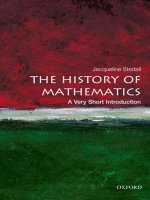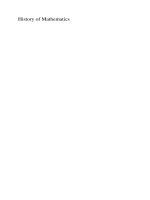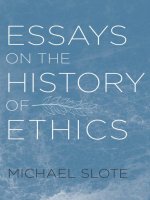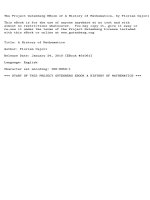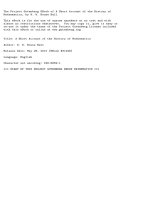The history of mathematics
Bạn đang xem bản rút gọn của tài liệu. Xem và tải ngay bản đầy đủ của tài liệu tại đây (1.44 MB, 117 trang )
The History of Mathematics: A Very Short
Introduction
VERY SHORT INTRODUCTIONS are for anyone wanting a stimulating and accessible way in to a
new subject. They are written by experts, and have been published in more than 25 languages
worldwide.
The series began in 1995, and now represents a wide variety of topics in history, philosophy,
religion, science, and the humanities. The VSI library now contains 300 volumes a Very Short
Introduction to everything from ancient Egypt and Indian philosophy to conceptual art and
cosmology and will continue to grow in a variety of disciplines.
Very Short Introductions available now:
ADVERTISING Winston Fletcher
AFRICAN HISTORY John Parker and Richard Rathbone
AGNOSTICISM Robin Le Poidevin
AMERICAN IMMIGRATION
David A. Gerber
AMERICAN POLITICAL PARTIES AND ELECTIONS L. Sandy Maisel
THE AMERICAN PRESIDENCY Charles O. Jones
ANARCHISM Colin Ward
ANCIENT EGYPT Ian Shaw
ANCIENT GREECE Paul Cartledge
ANCIENT PHILOSOPHY Julia Annas
ANCIENT WARFARE
Harry Sidebottom
ANGELS David Albert Jones
ANGLICANISM Mark Chapman
THE ANGLO-SAXON AGE John Blair
THE ANIMAL KINGDOM
Peter Holland
ANIMAL RIGHTS David DeGrazia
ANTISEMITISM Steven Beller
THE APOCRYPHAL GOSPELS
Paul Foster
ARCHAEOLOGY Paul Bahn
ARCHITECTURE Andrew Ballantyne
ARISTOCRACY William Doyle
ARISTOTLE Jonathan Barnes
ART HISTORY Dana Arnold
ART THEORY Cynthia Freeland
ATHEISM Julian Baggini
AUGUSTINE Henry Chadwick
AUTISM Uta Frith
THE AZTECS Davíd Carrasco
BARTHES Jonathan Culler
BEAUTY Roger Scruton
BESTSELLERS John Sutherland
THE BIBLE John Riches
BIBLICAL ARCHAEOLOGY
Eric H. Cline
BIOGRAPHY Hermione Lee
THE BLUES Elijah Wald
THE BOOK OF MORMON
Terryl Givens
THE BRAIN Michael O’Shea
BRITISH POLITICS Anthony Wright
BUDDHA Michael Carrithers
BUDDHISM Damien Keown
BUDDHIST ETHICS Damien Keown
CANCER Nicholas James
CAPITALISM James Fulcher
CATHOLICISM Gerald O’Collins
THE CELL Terence Allen and
Graham Cowling
THE CELTS Barry Cunliffe
CHAOS Leonard Smith
CHILDREN’S LITERATURE
Kimberley Reynolds
CHINESE LITERATURE Sabina Knight
CHOICE THEORY Michael Allingham
CHRISTIAN ART Beth Williamson
CHRISTIAN ETHICS D. Stephen Long
CHRISTIANITY Linda Woodhead
CITIZENSHIP Richard Bellamy
CLASSICAL MYTHOLOGY
Helen Morales
CLASSICS Mary Beard and
John Henderson
CLAUSEWITZ Michael Howard
THE COLD WAR Robert McMahon
COLONIAL LATIN AMERICAN LITERATURE Rolena Adorno
COMMUNISM Leslie Holmes
THE COMPUTER Darrel Ince
THE CONQUISTADORS
Matthew Restall and
Felipe Fernandez-Armesto
CONSCIENCE Paul Strohm
CONSCIOUSNESS Susan Blackmore
CONTEMPORARY ART
Julian Stallabrass
CONTINENTAL PHILOSOPHY
Simon Critchley
COSMOLOGY Peter Coles
CRITICAL THEORY
Stephen Eric Bronner
THE CRUSADES Christopher Tyerman
CRYPTOGRAPHY Fred Piper and
Sean Murphy
THE CULTURAL REVOLUTION
Richard Curt Kraus
DADA AND SURREALISM
David Hopkins
DARWIN Jonathan Howard
THE DEAD SEA SCROLLS Timothy Lim
DEMOCRACY Bernard Crick
DERRIDA Simon Glendinning
DESCARTES Tom Sorell
DESERTS Nick Middleton
DESIGN John Heskett
DEVELOPMENTAL BIOLOGY
Lewis Wolpert
DICTIONARIES Lynda Mugglestone
DINOSAURS David Norman
DIPLOMACY Joseph M. Siracusa
DOCUMENTARY FILM
Patricia Aufderheide
DREAMING J. Allan Hobson
DRUGS Leslie Iversen
DRUIDS Barry Cunliffe
EARLY MUSIC Thomas Forrest Kelly
THE EARTH Martin Redfern
ECONOMICS Partha Dasgupta
EGYPTIAN MYTH Geraldine Pinch
EIGHTEENTH-CENTURY BRITAIN
Paul Langford
THE ELEMENTS Philip Ball
EMOTION Dylan Evans
EMPIRE Stephen Howe
ENGELS Terrell Carver
ENGLISH LITERATURE Jonathan Bate
ENVIRONMENTAL ECONOMICS
Stephen Smith
EPIDEMIOLOGY Rodolfo Saracci
ETHICS Simon Blackburn
THE EUROPEAN UNION
John Pinder and Simon Usherwood
EVOLUTION Brian and
Deborah Charlesworth
EXISTENTIALISM Thomas Flynn
FASCISM Kevin Passmore
FASHION Rebecca Arnold
FEMINISM Margaret Walters
FILM Michael Wood
FILM MUSIC Kathryn Kalinak
THE FIRST WORLD WAR
Michael Howard
FOLK MUSIC Mark Slobin
FORENSIC PSYCHOLOGY
David Canter
FORENSIC SCIENCE Jim Fraser
FOSSILS Keith Thomson
FOUCAULT Gary Gutting
FREE SPEECH Nigel Warburton
FREE WILL Thomas Pink
FRENCH LITERATURE John D. Lyons
THE FRENCH REVOLUTION
William Doyle
FREUD Anthony Storr
FUNDAMENTALISM Malise Ruthven
GALAXIES John Gribbin
GALILEO Stillman Drake
GAME THEORY Ken Binmore
GANDHI Bhikhu Parekh
GENIUS Andrew Robinson
GEOGRAPHY John Matthews and
David Herbert
GEOPOLITICS Klaus Dodds
GERMAN LITERATURE Nicholas Boyle
GERMAN PHILOSOPHY Andrew Bowie
GLOBAL CATASTROPHES Bill McGuire
GLOBAL ECONOMIC HISTORY
Robert C. Allen
GLOBAL WARMING Mark Maslin
GLOBALIZATION Manfred Steger
THE GREAT DEPRESSION AND
THE NEW DEAL Eric Rauchway
HABERMAS James Gordon Finlayson
HEGEL Peter Singer
HEIDEGGER Michael Inwood
HERODOTUS Jennifer T. Roberts
HIEROGLYPHS Penelope Wilson
HINDUISM Kim Knott
HISTORY John H. Arnold
THE HISTORY OF ASTRONOMY
Michael Hoskin
THE HISTORY OF LIFE
Michael Benton
THE HISTORY OF MATHEMATICS
Jacqueline Stedall
THE HISTORY OF
MEDICINE William Bynum
THE HISTORY OF TIME
Leofranc Holford-Strevens
HIV/AIDS Alan Whiteside
HOBBES Richard Tuck
HUMAN EVOLUTION Bernard Wood
HUMAN RIGHTS Andrew Clapham
HUMANISM Stephen Law
HUME A. J. Ayer
IDEOLOGY Michael Freeden
INDIAN PHILOSOPHY Sue Hamilton
INFORMATION Luciano Floridi
INNOVATION Mark Dodgson and
David Gann
INTELLIGENCE Ian J. Deary
INTERNATIONAL
MIGRATION Khalid Koser
INTERNATIONAL RELATIONS
Paul Wilkinson
ISLAM Malise Ruthven
ISLAMIC HISTORY Adam Silverstein
ITALIAN LITERATURE
Peter Hainsworth and David Robey
JESUS Richard Bauckham
JOURNALISM Ian Hargreaves
JUDAISM Norman Solomon
JUNG Anthony Stevens
KABBALAH Joseph Dan
KAFKA Ritchie Robertson
KANT Roger Scruton
KEYNES Robert Skidelsky
KIERKEGAARD Patrick Gardiner
THE KORAN Michael Cook
LANDSCAPES AND
GEOMORPHOLOGY
Andrew Goudie and Heather Viles
LATE ANTIQUITY Gillian Clark
LAW Raymond Wacks
THE LAWS OF THERMODYNAMICS
Peter Atkins
LEADERSHIP Keith Grint
LINCOLN Allen C. Guelzo
LINGUISTICS Peter Matthews
LITERARY THEORY Jonathan Culler
LOCKE John Dunn
LOGIC Graham Priest
MACHIAVELLI Quentin Skinner
MADNESS Andrew Scull
MAGIC Owen Davies
THE MARQUIS DE SADE John Phillips
MARTIN LUTHER Scott H. Hendrix
MARX Peter Singer
MATHEMATICS Timothy Gowers
THE MEANING OF LIFE
Terry Eagleton
MEDICAL ETHICS Tony Hope
MEDIEVAL BRITAIN John Gillingham
and Ralph A. Griffiths
MEMORY Jonathan K. Foster
MICHAEL FARADAY
Frank A. J. L. James
MODERN ART David Cottington
MODERN CHINA Rana Mitter
MODERN FRANCE
Vanessa R. Schwartz
MODERN IRELAND Senia Pašeta
MODERN JAPAN
Christopher Goto-Jones
MODERN LATIN AMERICAN
LITERATURE
Roberto González Echevarría
MODERNISM Christopher Butler
MOLECULES Philip Ball
MORMONISM
Richard Lyman Bushman
MUHAMMAD Jonathan A.C. Brown
MULTICULTURALISM Ali Rattansi
MUSIC Nicholas Cook
MYTH Robert A. Segal
NATIONALISM Steven Grosby
NELSON MANDELA
Elleke Boehmer
NEOLIBERALISM Manfred Steger and
Ravi Roy
THE NEW TESTAMENT
Luke Timothy Johnson
THE NEW TESTAMENT AS
LITERATURE Kyle Keefer
NEWTON Robert Iliffe
NIETZSCHE Michael Tanner
NINETEENTH-CENTURY
BRITAIN Christopher Harvie and
H. C. G. Matthew
THE NORMAN CONQUEST
George Garnett
NORTH AMERICAN INDIANS
Theda Perdue and Michael D. Green
NORTHERN IRELAND
Marc Mulholland
NOTHING Frank Close
NUCLEAR POWER Maxwell Irvine
NUCLEAR WEAPONS
Joseph M. Siracusa
NUMBERS Peter M. Higgins
THE OLD TESTAMENT
Michael D. Coogan
ORGANIZATIONS Mary Jo Hatch
PAGANISM Owen Davies
PARTICLE PHYSICS Frank Close
PAUL E. P. Sanders
PENTECOSTALISM William K. Kay
THE PERIODIC TABLE Eric R. Scerri
PHILOSOPHY Edward Craig
PHILOSOPHY OF LAW
Raymond Wacks
PHILOSOPHY OF SCIENCE
Samir Okasha
PHOTOGRAPHY Steve Edwards
PLANETS David A. Rothery
PLATO Julia Annas
POLITICAL PHILOSOPHY
David Miller
POLITICS Kenneth Minogue
POSTCOLONIALISM Robert Young
POSTMODERNISM Christopher Butler
POSTSTRUCTURALISM
Catherine Belsey
PREHISTORY Chris Gosden
PRESOCRATIC PHILOSOPHY
Catherine Osborne
PRIVACY Raymond Wacks
PROGRESSIVISM Walter Nugent
PROTESTANTISM Mark A. Noll
PSYCHIATRY Tom Burns
PSYCHOLOGY Gillian Butler and
Freda McManus
PURITANISM Francis J. Bremer
THE QUAKERS Pink Dandelion
QUANTUM THEORY
John Polkinghorne
RACISM Ali Rattansi
THE REAGAN REVOLUTION Gil Troy
REALITY Jan Westerhoff
THE REFORMATION Peter Marshall
RELATIVITY Russell Stannard
RELIGION IN AMERICA Timothy Beal
THE RENAISSANCE Jerry Brotton
RENAISSANCE ART
Geraldine A. Johnson
RISK Baruch Fischhoff and John Kadvany
ROMAN BRITAIN Peter Salway
THE ROMAN EMPIRE
Christopher Kelly
ROMANTICISM Michael Ferber
ROUSSEAU Robert Wokler
RUSSELL A. C. Grayling
RUSSIAN LITERATURE Catriona Kelly
THE RUSSIAN REVOLUTION
S. A. Smith
SCHIZOPHRENIA Chris Frith and
Eve Johnstone
SCHOPENHAUER Christopher Janaway
SCIENCE AND RELIGION
Thomas Dixon
SCIENCE FICTION David Seed
THE SCIENTIFIC REVOLUTION
Lawrence M. Principe
SCOTLAND Rab Houston
SEXUALITY Véronique Mottier
SHAKESPEARE Germaine Greer
SIKHISM Eleanor Nesbitt
SLEEP Steven W. Lockley and
Russell G. Foster
SOCIAL AND CULTURAL
ANTHROPOLOGY
John Monaghan and Peter Just
SOCIALISM Michael Newman
SOCIOLOGY Steve Bruce
SOCRATES C. C. W. Taylor
THE SOVIET UNION Stephen Lovell
THE SPANISH CIVIL WAR
Helen Graham
SPANISH LITERATURE Jo Labanyi
SPINOZA Roger Scruton
STATISTICS David J. Hand
STEM CELLS Jonathan Slack
STUART BRITAIN John Morrill
SUPERCONDUCTIVITY
Stephen Blundell
TERRORISM Charles Townshend
THEOLOGY David F. Ford
THOMAS AQUINAS Fergus Kerr
TOCQUEVILLE Harvey C. Mansfield
TRAGEDY Adrian Poole
THE TUDORS John Guy
TWENTIETH-CENTURY BRITAIN
Kenneth O. Morgan
THE UNITED NATIONS
Jussi M. Hanhimäki
THE U.S. CONGRESS Donald A. Ritchie
THE U.S. SUPREME COURT Linda Greenhouse
UTOPIANISM Lyman Tower Sargent
THE VIKINGS Julian Richards
VIRUSES Dorothy H. Crawford
WITCHCRAFT Malcolm Gaskill
WITTGENSTEIN A. C. Grayling
WORLD MUSIC Philip Bohlman
THE WORLD TRADE
ORGANIZATION Amrita Narlikar
WRITING AND SCRIPT
Andrew Robinson
Available Soon:
PLAGUE Paul Slack
RUSSIAN HISTORY
Geoffrey Hosking
PROBABILITY John Haigh
PLANTS Timothy Walker
For more information visit our website
www.oup.com/vsi
Jacqueline Stedall
THE HISTORY OF MATHEMATICS
A Very Short Introduction
Great Clarendon Street, Oxford ox2 6dp
Oxford University Press is a department of the University of Oxford.
It furthers the University’s objective of excellence in research, scholarship,
and education by publishing worldwide in
Oxford New York
Auckland Cape Town Dar es Salaam Hong Kong Karachi
Kuala Lumpur Madrid Melbourne Mexico City Nairobi
New Delhi Shanghai Taipei Toronto
With offices in
Argentina Austria Brazil Chile Czech Republic France Greece
Guatemala Hungary Italy Japan Poland Portugal Singapore
South Korea Switzerland Thailand Turkey Ukraine Vietnam
Oxford is a registered trade mark of Oxford University Press
in the UK and in certain other countries
Published in the United States
by Oxford University Press Inc., New York
© Jacqueline Stedall 2012
The moral rights of the author have been asserted
Database right Oxford University Press (maker)
First Published 2012
All rights reserved. No part of this publication may be reproduced,
stored in a retrieval system, or transmitted, in any form or by any means,
without the prior permission in writing of Oxford University Press,
or as expressly permitted by law, or under terms agreed with the appropriate
reprographics rights organization. Enquiries concerning reproduction
outside the scope of the above should be sent to the Rights Department,
Oxford University Press, at the address above
You must not circulate this book in any other binding or cover
and you must impose the same condition on any acquirer
British Library Cataloguing in Publication Data
Data available
Library of Congress Cataloging in Publication Data
Data available
Typeset by SPI Publisher Services, Pondicherry, India
Printed in Great Britain on acid-free paper by
Ashford Colour Press Ltd, Gosport, Hampshire
ISBN 978-0-19-959968-4
1 3 5 7 9 10 8 6 4 2
Contents
Acknowledgements
List of illustrations
Introduction
1 Mathematics: myth and history
2 What is mathematics and who is a mathematician?
3 How are mathematical ideas disseminated?
4 Learning mathematics
5 Mathematical livelihoods
6 Getting inside mathematics
7 The evolving historiography of mathematics
Further reading
Index
Acknowledgements
In writing this Very Short Introduction to a very large topic I have been greatly inspired by
other authors in the series, so many of whom have risen to a similarly demanding challenge in
imaginative and thought-provoking ways.
It has been my privilege over the last few years to edit both The Oxford Handbook of the
History of Mathematics and the BSHM Bulletin, the journal of the British Society for the
History of Mathematics. This has led me into close working relationships with more than
eighty authors writing on the history of mathematics from a wide variety of perspectives. I
have learned something from every one of them. Much of that work was done alongside
Eleanor Robson, best of friends and colleagues, and I am immensely grateful to her for the
hours of companionship and discussion that have helped to shape the picture I have attempted
to convey in this book. In particular, I have drawn on the research and expertise of Markus
Asper, Sonja Brentjes, Christopher Cullen, Marit Hartveit, Annette Imhausen, Kim Plofker,
Eleanor Robson, Corinna Rossi, Simon Singh, Polly Thanailaki, and Benjamin Wardhaugh;
books and articles by these authors and some others will be found in the suggestions for
further reading at the end.
The John Hersee collection of children’s copy books, discussed in Chapter 4, is the property of
the Mathematical Association, and is housed in the David Wilson Library at the University of
Leicester. I thank the Association’s archivists, Mary Walmsley and Mike Price, for their
generous hospitality and collaboration in that part of my research. I am also grateful to Joanna
Parker of Worcester College, Oxford, for allowing me to see John Aubrey’s copy of Anne
Ettrick’s notebook. I am indebted to Andrew Wiles, Christopher Cullen, Eleanor Robson, and
Adam Silverstein for taking the trouble to check details in Chapters 1, 2, 4, and 5 respectively.
I record my warm thanks to them and all others who have commented astutely on various
aspects of the text: anonymous OUP readers, together with Peter Neumann, Harvey Lederman,
Jesse Wolfson, and all the members of my immediate family, some of whom never thought to
read about the history of mathematics until now.
List of illustrations
1 ‘Colourwash’ by Tatjana Tekkel Peppé who, by her own account, is no good at
mathematics
© Photo Jonathan Peppé
2 John Dee’s ‘groundplat’ from his preface to Euclid’s Elements, 1570
© The British Library Board
3 The first page of the first printed edition of Euclid’s Elements, 1482
© Wikipedia Commons
4 The front page of Robert Smith’s arithmetic book, Greenrow Academy, 1832
© Photo Mary Walmsley
5 A problem in trigonometry, illustrated and answered by Robert Smith, Greenrow
Academy, 1832
© Photo Mary Walmsley
6 The first page of Ann Weetman’s exercise book, dated ‘Oct 20 1834’
© Photo Mary Walmsley
7 One of the final pages of Ann Weetman’s exercise book, dated ‘April 12 1837’
© Photo Mary Walmsley
8 Thābit ibn Qurra’s proof of Pythagoras’ Theorem
9 Euclid’s proof of Pythagoras’ Theorem
10 Oliver Byrne’s proof of Pythagoras’ Theorem
© Wikipedia Commons
Introduction
Mathematics has a history that stretches back for at least 4,000 years and reaches into every
civilization and culture. It might be possible, even in an introduction as very short as this
book, to outline some key mathematical events and discoveries in roughly chronological
order. Indeed, this is probably what most readers will expect. There can be several problems,
however, with that kind of exposition.
The first is that such accounts tend to portray a whig version of mathematical history, in which
mathematical understanding is generally perceived to progress onwards and upwards towards
the splendid achievements of the present day. Unfortunately, those looking for evidence of
progress tend to overlook the complexities, lapses, and dead ends that are an inevitable part of
any human endeavour, including mathematics; sometimes failure can be as revealing as
success. Besides, by defining present-day mathematics as the benchmark against which earlier
efforts are to be measured, we can too easily come to regard the contributions of the past as
valiant but ultimately outdated efforts. Instead, in looking to see how this or that fact or
theorem originated, we need to see discoveries in the context of their own time and place.
A second problem, about which I shall have more to say later, is that chronological accounts
all too often follow a ‘stepping stone’ style, in which discoveries are placed before us one
after another without the all-important connections between them. The aim of the historian is
not merely to compile dated lists of events but to throw light on the influences and
interactions that led to them. This will be a recurring theme of this book.
A third problem is that key events and discoveries come to be associated with key people.
Further, in most histories of mathematics, most of those people will have lived in western
Europe from about the 16th century onwards and will be male. This does not necessarily
reflect Eurocentric or sexist attitudes on the part of the writers. The rapid pace of development
of mathematics in the masculine culture of Europe since the Renaissance has led to a large
amount of material that historians have rightly thought worth investigating; besides, we have a
wealth of sources from Europe for this period, as opposed to only a handful, in relative terms,
for pre-medieval Europe, China, India, or America. Fortunately, the availability and
accessibility of sources from some of these other areas is beginning to improve. The fact
remains, however, that focussing on big discoveries rules out the mathematical experience of
most of the human race: women, children, accountants, teachers, engineers, factory workers,
and so on, often entire continents and centuries of them. Clearly this will not do. Without
denying the value of certain notable breakthroughs (and this book will begin with one of them)
there have to be ways of thinking about history in terms of the many who practise
mathematics, not just a few.
This book can do only a little to redress the masculine bias of most depictions of the history of
mathematics; it can, however, pay more than lip service to the mathematics of continents
other than Europe; and it will attempt to explore how, where, and why mathematics has been
practised by people whose names will never appear in standard histories. To do so, however,
requires something different from the usual chronological survey.
The alternative model that I propose to follow will be built around themes rather than periods.
Each chapter will focus on two or three case studies, chosen not because they are in any way
comprehensive or exhaustive but in the hope that they will suggest ideas and questions and
fresh ways of thinking. At the same time, in keeping with the ideals proclaimed above, I have
tried wherever possible to draw out contrasts or similarities between the various stories, so
that readers can build up an interconnected view of at least a few aspects of the very long
history of mathematics. My aim has been to demonstrate not only how professional historians
now approach their discipline but how the layperson too can think about mathematical history.
In this way, I hope that this book will help the reader to recognize the richness and diversity of
mathematical activity throughout human history; and that it will be a very short introduction
not just to some of the mathematics of the past but to the history of mathematics itself as a
modern academic discipline.
Chapter 1
Mathematics: myth and history
It is not often that a thorny old mathematical problem makes the news, but in 1993 newspapers
in Britain, France, and the United States announced that a 40-year-old mathematician called
Andrew Wiles, in a lecture at the Isaac Newton Institute in Cambridge, had demonstrated a
proof of a 350-year-old problem known as Fermat’s Last Theorem. As it turned out, the claim
was a little premature: Wiles’s 200 pages of mathematics contained an error that took a little
while to fix, but two years later the proof was secure. The story of Wiles’s nine-year struggle
with the theorem became the subject of a book and of a television film in which Wiles was
moved to tears as he spoke of his final breakthrough.
One reason that this piece of mathematical history so caught the public imagination was
undoubtedly the figure of Wiles himself. For seven years before the Cambridge lecture, he had
worked in near isolation, devoting himself single-mindedly to the deep and complicated
mathematics underlying the theorem. Here then was a story to which those brought up in the
mythologies of western culture were already well attuned: the lonely hero struggling against
the odds to attain an elusive goal. There was even a princess in the background: only his wife
knew of Wiles’s ultimate purpose, and was the first to receive the finished proof, as a birthday
present.
A second reason is that although the eventual proof of Fermat’s Last Theorem was fully
understood by perhaps no more than 20 people in the world, the theorem itself is easily stated.
Wiles was already intrigued by it when he was 10 years old, and even those who have long ago
forgotten most of the mathematics they ever learned can grasp what it is about; we will return
to it in a moment.
Before that, however, note that in the very first sentence of this chapter three people were
already mentioned by name: Wiles, Newton, and Fermat. In mathematics this is typical: it is
universal practice for mathematicians to name theorems, conjectures, or buildings after one of
the tribe. This is because most mathematicians are keenly aware that they continuously build
on work done by their predecessors or their colleagues. In other words, mathematics is an
innately historical subject in which past endeavours are rarely far out of mind. To begin to
think about the questions that historians of mathematics ask, let us pursue Fermat’s Last
Theorem backwards from that Cambridge lecture theatre in 1993 to its more remote
beginnings.
Fermat and his theorem
Pierre de Fermat, born in 1601, spent his entire life in southern France. A lawyer by training,
he was a Counselor to the Parlement of Toulouse, the judicial body for a large surrounding
area. In his spare time, which was little enough, Fermat worked on mathematics, and being far
removed from circles of intellectual activity in Paris he did so almost entirely alone. During
the 1630s he corresponded with mathematicians further afield, through the Parisian Minim
friar Marin Mersenne, but during the 1640s, as the political pressures on him increased, he
withdrew once again into mathematical isolation. Fermat achieved some of the most profound
results of early 17th-century mathematics but for the most part was prepared to say
tantalizingly little about them. Time and again he promised his correspondents that he would
fill in the details when he had enough leisure to do so, but that leisure never came. Sometimes
he would offer a bare statement of what he had found, or he would send out challenges that
plainly demonstrated the ideas he was working on but without giving away his hard-won
results.
The first hint of his Last Theorem appeared in such a challenge, sent to the English
mathematicians John Wallis and William Brouncker in 1657; they failed to see what he was
driving at and dismissed it as being beneath their dignity. Only after Fermat’s death, when
some of his notes and papers were edited by his son Samuel, did the full statement of the
theorem emerge, scribbled in the margin of Fermat’s copy of the Arithmetica of Diophantus.
Before taking another step back in time to see what it was in Diophantus that inspired Fermat,
we need to digress briefly to some mathematics, Fermat’s Last Theorem itself.
The one bit of mathematics that almost everyone recalls from their schooldays is Pythagoras’
Theorem, which states that the square on the longest side of a right-angled triangle, the
hypotenuse, is equal to the sum of the squares on the two shorter sides, the ‘legs’. Most people
will probably also remember that if the two short sides are respectively 3 and 4 units in length
then the long side will be 5 units, because 3
2
+ 4
2
= 5
2
. This kind of triangle is known as a 3-4-
5 triangle and may conveniently be used for marking out right angles on the ground with a
piece of rope, or by textbook writers who want to set problems that can be solved without
resort to a calculator. There are plenty of other sets of three whole numbers that satisfy the
same relationship: it is easy to check that 5
2
+ 12
2
= 13
2
, for instance, or that 8
2
+ 15
2
= 17
2
.
Such sets, sometimes written as (3, 4, 5), (5, 12, 13), and so on, are known as ‘Pythagorean
triples’, and there are infinitely many of them.
Now suppose that, as mathematicians like to do, we tweak the conditions a bit and see what
happens. What if, instead of taking the squares of each number, we take their cubes? Can we
find triples (a, b, c) that satisfy a
3
+ b
3
= c
3
? Or can we be even wilder and ask for a triple that
satisfies a
7
+ b
7
= c
7
or even a
101
+ b
101
= c
101
? The conclusion Fermat came to was that there
is no point in trying: we cannot do it for any power beyond squares. As so often, however, he
left it to others to work out the details. This time, his excuse was not time but space: he had
discovered a marvellous proof, he said, but the margin was too meagre to contain it.
The margin in question belonged to page 85 of Claude Gaspar Bachet’s 1621 edition of the
Arithmetica of Diophantus. The Arithmetica had intrigued European mathematicians ever
since a manuscript copy, written in Greek, had been rediscovered in Venice in 1462. About
Diophantus himself, no-one knew anything, and little more is known now. The manuscript
refers to him as ‘Diophantus of Alexandria’ so we may suppose that he lived and worked for a
significant part of his life in that Greek-speaking city of northern Egypt. Whether he was a
native Egyptian or an incomer from some other part of the Mediterranean world, we do not
know. And any estimate for his dates is no more than guesswork. Diophantus cited a definition
from Hypsicles (c. 150 BC), while Theon (c. AD 350) cited a result from Diophantus. That pins
him down to within 500 years, but we cannot do better than that.
Compared with the geometric texts that have survived from other Greek mathematical writers,
the Arithmetica is highly unusual. Its subject matter is not geometry but nor is it the arithmetic
of everyday accounting. Rather, it is a set of sophisticated problems asking for whole numbers
or fractions that must satisfy certain conditions. The eighth problem of the second book, for
example, asks the reader to ‘divide a square into two squares’. For our present purposes, we
may translate this into a more modern mode of expression and see that Diophantus’ question
was related to Pythagorean triples, where a given square (in the notation above, c
2
) may be
divided or separated into two smaller squares (a
2
+ b
2
). Diophantus showed a clever way of
achieving this when the largest square is 16 (in which case the answer involves fractions); and
then he moved on to something else.
Fermat, however, hesitated at this point and must have asked himself the obvious question:
can the method be extended? Can one ‘divide a cube into two cubes’? This was precisely the
question he posed to Wallis and Brouncker in 1657 (and to which, after Fermat had later
reported that it was impossible, Wallis angrily retorted that such ‘negative’ questions were
absurd). What Fermat suggested in the margin in fact applied not only to cubes but to any
higher power at all, a long way beyond anything required by Diophantus.
One other name has recurred throughout the above account, so let us now take one further
historical step backwards, from Diophantus to Pythagoras, who is supposed to have lived on
the Greek island of Samos around 500 BC. Despite this very early date, many readers will
probably feel much more at home with Pythagoras than with Diophantus: indeed the question I
am most commonly asked as a historian of mathematics is: ‘Do you go all the way back to
Pythagoras?’ It is true that Pythagoras’ Theorem has been known for a very long time; the
disappointing news is that there is no evidence to link it to Pythagoras. In fact, there is little
evidence to link anything to Pythagoras. If Diophantus is a shadowy figure, Pythagoras is
buried under a blanket of myth and legend. We have no texts written by him or his immediate
followers. The earliest surviving accounts of his life are from the third century AD, about 800
years after he lived, by writers with their own philosophical axes to grind. His supposed
journeys to Babylon, or to Egypt, where he was said to have learned geometry, were probably
no more than fictions used by such writers to bolster Pythagoras’ standing and authority. As to
the tales of what his followers are supposed to have done or believed, there may be some
foundation for them in fact, but it is impossible to be certain of any of them. In short,
Pythagoras became, literally, a legendary figure, to whom much was ascribed but of whom
little was known in reality.
The lives of these four men, Pythagoras, Diophantus, Fermat, Wiles, span more than 2,000
years of mathematical history. We can certainly trace similar mathematical ideas running
through the stories about each of them even though they are spaced several centuries apart.
Have we then ‘done’ the history of Fermat’s Last Theorem from start to finish? The answer is
‘no’, and for many reasons. The first is that one task of the historian is to disentangle fiction
from fact, and myth from history. This is not to underestimate the value of either fiction or
myth: both embody the stories by which societies define and understand themselves, and may
have deep and lasting value. The historian, however, must not allow those stories to obscure
evidence that may point to other interpretations. In the case of Pythagoras, it is relatively easy
to see how and why tales that appear robust have been spun from the flimsiest of threads, but
in the case of Andrew Wiles, where we believe we have the facts in front of our eyes, it is
much harder. The truth of almost any story is almost always more complex than we first
imagine or than the authors would sometimes have us believe, and stories about mathematics
and mathematicians are no exception. The rest of this chapter examines some common myths
and pitfalls in the history of mathematics; for convenience, I have called them ‘Ivory tower
history’, ‘Stepping-stone history’, and ‘Elite history’. The rest of the book will then offer
some alternative approaches.
Ivory tower history
One of the most remarkable features of Wiles’s story is the fact that he deliberately shut
himself away for seven years so that he could pursue the proof of the Last Theorem without
interruption or interference. Fermat too was clearly a loner, separated by geographical
distance if nothing else from those who might have been able to understand and appreciate his
work. We have spoken of Diophantus and Pythagoras also without any reference to their
contemporaries. Were these four men then really lonely geniuses forging new paths alone? Is
this how mathematics is done properly, or done best? Let us return to Pythagoras and this time
work forward.
The stories about Pythagoras persistently claim that he established or attracted around him a
community, or brotherhood, who shared certain religious and philosophical beliefs and
perhaps also some mathematical explorations. Unfortunately the stories also claim that the
brotherhood was bound to strict secrecy, which of course leaves room for endless speculation
about their activities. Even if there is only a grain of truth in such stories, however, it would
seem that Pythagoras was charismatic enough to attract followers. Indeed, the fact that his
name has survived at all suggests that he was respected and revered in his lifetime, and that he
was no hermit.
We are a little better able to place Diophantus, who in Alexandria would have been able to
enjoy the company of other scholars. He would also almost certainly have had access to books
gathered from other parts of the Mediterranean world in temple or private book collections. It
is possible that the problems of the Arithmetica were his own invention, but it could equally be
the case that he compiled them into a single collection from a variety of other sources, written
or oral. One of the recurring motifs of this book will be that mathematics repeatedly passes
from one person to another through the spoken word. Diophantus, like any other
mathematically creative person, almost certainly discussed his problems and their solutions
with a teacher or with students of his own. We should therefore think of him not as a silent
figure writing his books in private but as a citizen of a city where learning and intellectual
exchange were valued.
Even Fermat, confined to Toulouse and the rigours of full-time political employment, was not
quite as isolated as might first appear. One of his friends during his early studies in Bordeaux
was Etienne d’Espagnet, whose father had been a friend of the French lawyer and
mathematician François Viète. The works of Viète, otherwise rare but thus made available to
Fermat, were to have a profound influence upon his development as a mathematician. Another
friend, and fellow Counselor in Toulouse, was Pierre de Carcavi, who, when he moved to Paris
in 1636, took with him news of Fermat and his discoveries. Through Carcavi, Fermat became
known to Marin Mersenne, and through Mersenne he corresponded with Roberval, probably
the best mathematician in Paris at the time, and with Descartes in the Netherlands. Later he
communicated some of the discoveries arising from his studies of Diophantus to Blaise Pascal
in Rouen and to John Wallis in Oxford. Thus even Fermat, far from important centres of
learning, was connected into a network of correspondence that stretched across Europe, a
virtual community of scholars that later came to be called the Republic of Letters.
When it comes to Wiles, it is much easier to see the cracks in the ‘lone genius’ story: Wiles
was educated at Oxford and Cambridge, and later worked at Harvard, Bonn, Princeton, and
Paris, in all of which he was part of flourishing mathematical communities. The mathematical
clue that eventually gave direction to his interest in the Last Theorem was picked up from a
casual conversation with a fellow mathematician in Princeton; when after five years he needed


